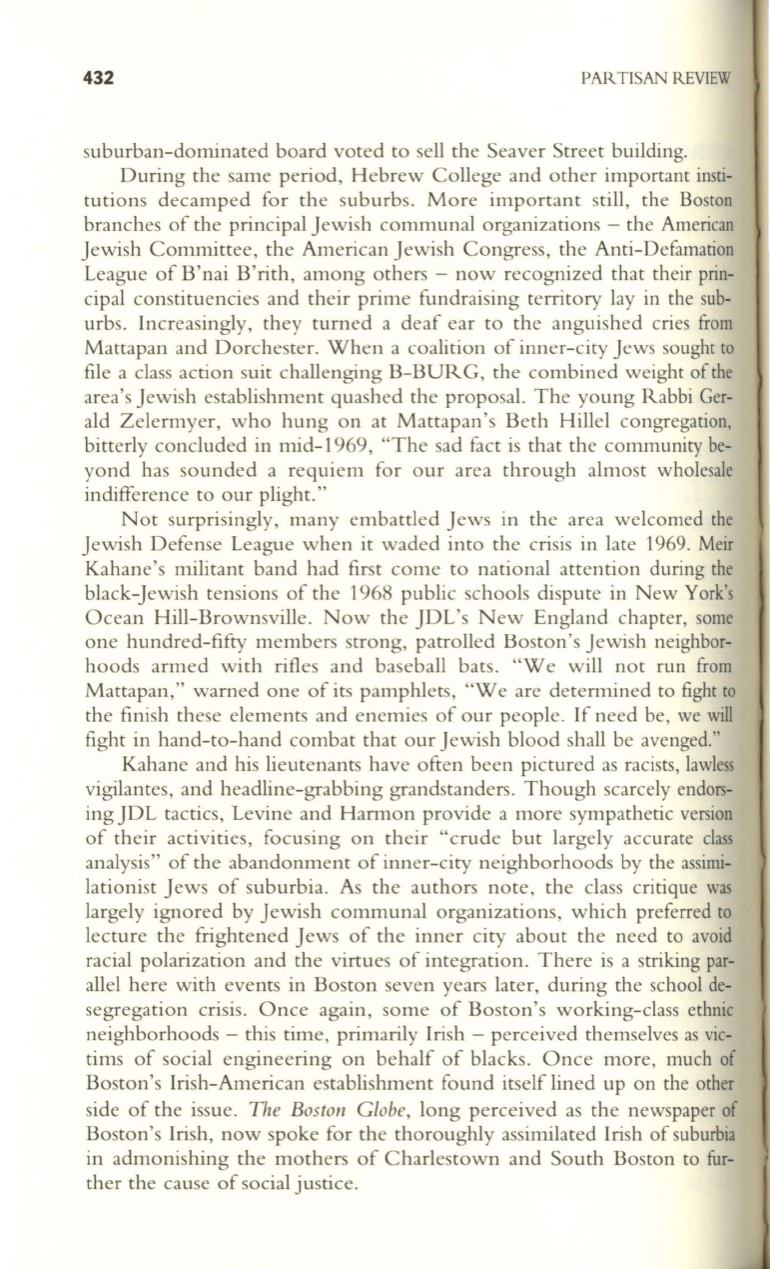
432
PARTISAN REVIEW
suburban-dominated board voted to sell the Seaver Street building.
During the same period, Hebrew College and other important insti–
tutions decamped for the suburbs. More important still, the Boston
branches of the principal Jewish communal organizations - the American
Jewish Committee, the American Jewish Congress, the Anti-Defamation
League of B'nai B'rith, among others - now recognized that their prin–
cipal constituencies and their prime fundraising territory lay in the sub–
urbs. Increasingly, they turned a deaf ear to the anguished cries from
Mattapan and Dorchester. When a coalition of inner-city Jews sought to
file a class action suit challenging B-BURG, the combined weight of the
area's Jewish establishment quashed the proposal. The young Rabbi Ger–
ald Zelermyer, who hung on at Mattapan's Beth Hillel congregation,
bitterly concluded in mid-1969, "The sad fact is that the community be–
yond has sounded a requiem for our area through almost wholesale
indifference to our plight."
Not surprisingly, many embattled Jews in the area welcomed the
Jewish Defense League when it waded into the crisis in late 1969. Meir
Kahane's militant band had first come to national attention during the
black-Jewish tensions of the 1968 public schools dispute in New York's
Ocean Hill-Brownsville. Now the JDL's New England chapter, some
one hundred-fifty members strong, patrolled Boston's Jewish neighbor–
hoods armed with rifles and baseball bats. "We will not run from
Mattapan," warned one of its pamphlets, "We are determined to fight to
the finish these elements and enemies of our people. If need be, we will
fight in hand-to-hand combat that our Jewish blood shall be avenged."
Kahane and his li eutenants have often been pictured as racists, lawless
vigilantes, and headline-grabbing grandstanders. Though scarcely endors–
ing JDL tactics, Levine and Harmon provide a more sympathetic version
of their activities, focusing on their "crude but largely accurate class
analysis" of the abandonment of inner-city neighborhoods by the assimi–
lationist Jews of suburbia. As the authors note, the class critique was
largely ignored by Jewish communal organizations, which preferred to
lecture the frightened Jews of the inner city about the need to avoid
racial polarization and the virtues of integration. There is a striking par–
allel here with events in Boston seven years later, during the school de–
segregation crisis. Once again, some of Boston's working-class ethnic
neighborhoods - this time, primarily Irish - perceived themselves as vic–
tims of social engineering on behalf of blacks. Once more, much of
Boston's Irish-American establishment found itself lined up on the other
side of the issue.
The Boston Globe,
long perceived as the newspaper of
Boston's Irish, now spoke for the thoroughly assimilated Irish of suburbia
in admonishing the mothers of Charlestown and South Boston to fur–
ther the cause of social justice.


